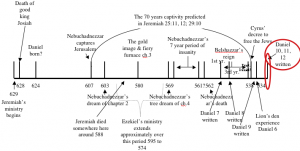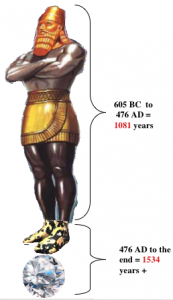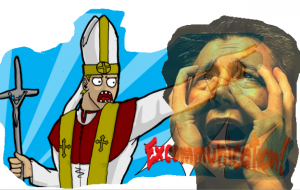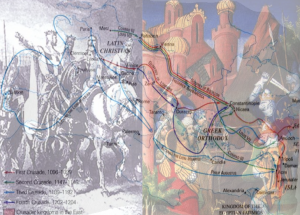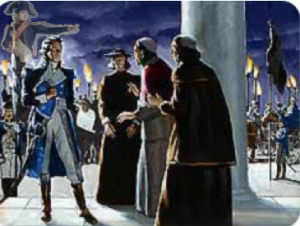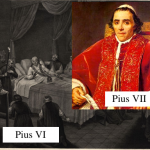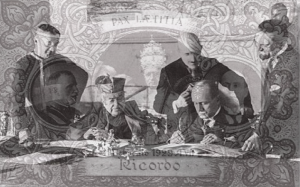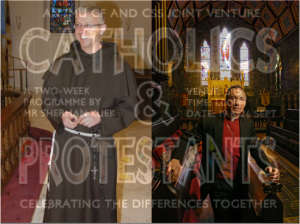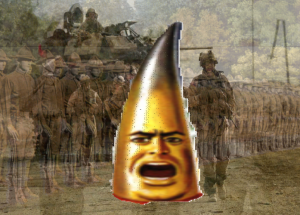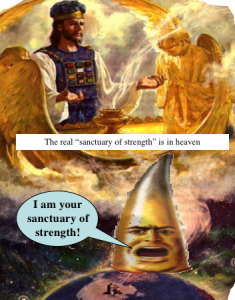In the previous section, in which we explored the first twenty verses, we found Gabriel following the same sequence of world empire as outlined in the image dream of Chapter 2, the beast vision of Chapter 7 and the ram/goat vision of Chapter 8. It ends up with the iron of Chapter 2, the fourth beast of Chapter 7 and the “transgressors” of Chapter 8.
This section will bring us to another transition point between the iron and the feet of Chapter 2, the fourth beast and the “little horn” of Chapter 7 and the “transgressors” and “little horn/king of fierce countenance” of Chapter 8.
In the next fifteen verses, let’s allow Gabriel to tell us where that transition point is:
Verse 21: And in his estate shall stand up a vile person, to whom they shall not give the honour of the kingdom: but he shall come in peaceably, and obtain the kingdom by flatteries.
As noted before, when Augustus died “Tiberius . . .was named his heir” “peaceably” without rancor or dispute, just as we understand from the witness of the historians. Therefore, it seems very clear that this “vile person” must be Tiberius Caesar who stood up “in [the] estate” of Julius Caesar for 50 years, from 14 B.C. to 37 A.D.
However, a quick survey of the next 24 verses reveals that the transitional phrase, “shall stand up” [91], is not used again until Daniel 12:1, when “Michael [shall] stand up.” Instead, the personal pronouns “he, him, his” and “himself (used more than 50 times throughout the remainder of this chapter)” invariably refer back to the “vile person” of Verse 21. That should compel us to reconsider our conclusion that Tiberius is the “vile person” who, Gabriel said, would “stand up.” It seems unlikely Gabriel would confer such importance on Tiberius, or even pagan Rome, throughout the remainder of this chapter.
Although pagan Rome receives much note in Chapter 2 by the “legs of iron” and the “fourth beast” of Chapter 7, Gabriel said little or nothing about it in Chapter 8. And while Gabriel describes the activities of two notable leaders of pagan Rome in Verses 16 to 20 in this chapter, it is reasonable to expect that he would turn the majority of his attention to the most deceitful figure in the prophecies of Daniel, that of the “little horn” of Daniel 7 and 8, and also the “king of fierce countenance” in Chapter 8, without wasting a lot of time on pagan Rome. Therefore, is it possible that the “vile person” is parallel to the “iron” in the “feet” of the image of Chapter 2, and the “little horn” of Chapters 8 and 9?
Going back to the great image of Chapter 2, it is clear that the head, chest, belly, and legs, beginning with ancient Babylon in 605 B.C. and ending with pagan Rome in 476 A.D., represent only 1,080 years of time, while the “feet of iron and of clay” represent more than 1,500 years because, I think we can all agree, the “stone” has not yet destroyed the image!
From that point alone, it seems more than reasonable for Gabriel to focus on a world power that will last until “the stone” smites “the image upon his feet” composed of “iron” mixed with “clay” (Daniel 2:34). We can expect he would focus on the time when “the kingdom and dominion, and the greatness of the kingdom under the whole heavens, shall be given to the people of the saints of the most High” (Daniel 7:27). Only then will papal Rome “be broken without hand” (Daniel 8:25).
The Commentary notes: “Certain historians maintain that there was a deliberate attempt by Suetonius, Seneca, and Tacitus to blacken the character of Tiberius. Doubtless the picture was overdrawn. Nevertheless sufficient factual evidence remains to show that Tiberius was an eccentric, misunderstood, and unloved person.” [92] But, being “eccentric, misunderstood, and unloved” falls short of being “vile!”
Another well-known commentator observes that “The ‘contemptible person,’ then, who was to arise in the place of Augustus, was the medieval pope . . .” [93] which puts Gabriel’s scenario ahead some 500 years from the time of Augustus. Nevertheless, that interpretation accords well with the rise of the “little horn” that “came up among” the other “ten” (Daniel 7:8) “peaceably” using his “mouth” to speak “great things” and only having a “look [that] was more stout than his fellows” (Daniel 7:20) “and by peace shall destroy many” (Daniel 8:25).
So, laying aside what “Tacitus records,” [94] other historians say: “Tiberius was a fine administrator, He carefully supervised tax collections and balanced the budget. He chose efficient governors for the provinces of Rome and maintained friendly relations with the neighboring kingdoms of Parthia and Armenia.” [95] Although “he came to be remembered as a dark, reclusive, and somber ruler . . . ‘the gloomiest of men’ . . . who never really wanted to be Emperor” he still deserves recognition as one of Rome’s greatest generals. Even prior to the beginning of his reign in “6 B.C., while on the verge of accepting command in the East and becoming the second-most powerful man in Rome, Tiberius announced his withdrawal from politics and retired to Rhodes . . . He seems to have wished for the Senate and the state to simply act without him and his direct orders were vague, inspiring debate more on what he actually meant than on passing his legislation. In his first few years, Tiberius seemed to have wanted the Senate to act alone, with no reference to him or his responsibilities as ‘first Senator.’ According to Tacitus, Tiberius derided the senate as ‘men fit to be slaves.’” [96] In other words, he despised them for being servile to himself! If he were truly “vile,” he would have felt himself exalted for their acquiescing to his every whim!
Clearly, such behavior does not correspond to “a vile person” seeking by subterfuge and “flatteries” to gain “the kingdom” by any and every possible means and then glory in the exercise of power over his fellow men. Furthermore, his successor, Caligula, the third emperor of the Roman Empire, who ruled 29 years from 12 to 41 A.D., behaved much more like a “vile person.” Even though “he is described as a noble and moderate ruler during the first six months of his rule. After this, the sources focus upon his cruelty, sadism, extravagance, and sexual perversion, presenting him as an insane tyrant . . . In early 41, Caligula was assassinated as the result of a conspiracy by officers of the Praetorian Guard, senators, and courtiers.” [97]
Verse 22: And with the arms of a flood shall they be overflown from before him, and shall be broken; yea, also the prince of the covenant.
The pronoun “they” represents those who did “not give the honour of the kingdom” to the “vile person” (Verse 21). In other words, those who had the power to “give,” but did not, are nevertheless “overflown,” [98] and their power “broken” or corrupted by the “flatteries” of the “vile person.”
Most certainly, the three horn powers that were “plucked up by the roots” by the “little horn” who “subdue[d] three kings” (Daniel 7:8, 24) are probable examples of those who were “overflown” by the “vile person,” the same power represented by the horn power.
But that was not all that was “overflown.” It was “also the prince of the covenant.”
The “prince of the covenant” is “Identical with the Prince who confirms the covenant in Daniel 9:25-27” [99], and also “the prince of the host” in Daniel 8:11 [100] which is Jesus Christ, the Messiah. If the “vile person” represents the papacy, then this could not be Jesus’ crucifixion [101], but rather a spiritual casting of “the place of his sanctuary” (Daniel 8:11) in heaven down to earth by pope and priest, who substituted themselves for Christ in the heavenly sanctuary.
Therefore, the overwhelming “flood,” Gabriel speaks of, is not the hoard of Roman soldiers who destroyed Jerusalem in A.D. 70 (Daniel 9:26) but the “flood” of false doctrine that gushed out of the “mouth” of the “little horn” “speaking great words against the most High” (Daniel 7:25) as he stood “up against the Prince of Princes” (Daniel 8:25).
Verse 23: And after the league made with him he shall work deceitfully: for he shall come up, and shall become strong with a small people.
Some believe this “league,” or a “joining together” is a retrospective look back during the time of pagan (rather than papal) Rome to 161 B.C. where a “League of assistance and friendship [was] arranged between the Jews and the Romans.” [102]
But this “league” or “alliance” [103] is really Gabriel’s terse word for the “vile person[’s]” modus operandi, or method of working; telling us how the “vile person” was able to “become strong with a small people.” A familiar term for this method is called a “concordat” which is “a formal agreement between the Pope and a government about church affairs.” [104] [105]
Time-after-time throughout history, the “vile person” has deceitfully and artfully turned many of the alliances (or “concordats”) to his own advantage, enabling him to infiltrate and utilize the power and prestige of other nations to foster his own growth and development.
Wylie puts it this way: “Riches, flattery, deference, continued to wait upon the Bishop of Rome. The emperor saluted him as Father; foreign Churches sustained him as judge in their disputes; heresiarchs sometimes fled to him for sanctuary; those who had favors to beg extolled his piety, or affected to follow his customs; and it is not surprising that his pride and ambition, fed by continual incense, continued to grow, till at last the presbyter of Rome, from being a vigilant pastor of a single congregation . . . raised his seat above his equals, mounted the throne of the patriarch, and exercised lordship over the heritage of Christ.” [106] D’Aubigne declares: “The praises and flattery, the exaggerated compliments and consultations of other Churches, became in her eyes and her hands the titles and documents of her authority. Such is man exalted to a throne: the incense of courts intoxicates him, his brain grows dizzy.” [107]
Verse 24: He shall enter peaceably even upon the fattest places of the province; and he shall do that which his fathers have not done, nor his fathers’ fathers; he shall scatter among them the prey, and spoil, and riches: yea, and he shall forecast his devices against the strong holds, even for a time.
Notice the seven personal pronouns used in this verse: “he, he, his, his, he, he” and “his.” All refer back to the “vile person” of Verse 21 of whom it is also said “he shall come in peaceably.” Interestingly, the verbs “enter” and “come in” are from the same Hebrew word “bow’” which could be translated “attack” [108] or, more plainly in this context: “invade.”
A peaceful invasion, or infiltration, is unlike the behavior of the “fourth beast,” representing pagan Rome, who was “dreadful and terrible, and strong exceedingly; and it had great iron teeth: it devoured and brake in pieces, and stamped the residue with the feet of it” (Daniel 7:7).
Although both types of invasions are unwelcome, the method employed by the “vile person” is unexpected or unanticipated. “Little by little, at first in stealth and silence, and then more openly as it increased in strength and gained control of the minds of men, the mystery of iniquity carried forward its deceptive and blasphemous work.” [109] None, even the “fattest places” or most prosperous countries were immune from its insidious invasions.
In spite of being accounted “a small people,” his strength became such that he was able to accomplish far more than any of his predecessors. Gabriel depicts his genealogy as “his fathers,” or even his great grandfather’s “father” which were the preceding nations represented by the legs of iron, belly of brass, chest of silver and head of gold in Chapter 2. Therefore, the “vile person” can be seen in the “feet” of the “image” as the “iron” intermingled with the “clay” of Nebuchadnezzar’s dream.
How can we account for such extraordinary power and influence? We would think the “fattest” (“richest”) “places of the province” would be well able to defend themselves against his encroachments. Even though they were not concerned with the threat of his army (which was very small), they were terrified by his pronouncements, believing “he” had the power of excommunication. They believed he could bar them from heaven and relegate them to the everlasting burnings of hell. Such gullibility stemmed from the simple fact they had no Bible with which to defend themselves against such notions.
His “usurped power increases like an avalanche. Admonitions, at first simply fraternal, soon became absolute commands in the mouth of the pontiff . . . Rome . . . smiled to see all nations voluntarily throwing themselves into her arms. She neglected no opportunity of increasing and extending her power” [110] and thereby did “that which his fathers have not done, nor his fathers’ fathers.”
“Thus there arose a hierarchy, assuming to mediate between God and men.” [111] The Babylonian, Medo-Persian, Grecian and pagan Roman kingdoms, craving stability, chose force of arms to maintain permanence. In contrast, the “vile person” “claimed to be successor of Peter, the Prince of the Apostles, and the Vicar of Christ . . . Henceforward he held neither of Caesar nor of Rome; he held immediately of Heaven. What one emperor had given, another emperor might take away. It did not suit the Pope to hold his office by so uncertain a tenure. He made haste, therefore, to place his supremacy where no future decree of emperor, no lapse of year, and no coming revolution could overturn it.” [112]
So, the “vile person” succeeded in eclipsing, in the minds of men, Christ’s position in heaven. In this way “he magnified himself even to the prince of the host, and by him the daily . . . was taken away . . .” (Daniel .8:11). Consequently, after the barbarians from the North (represented by the “ten horns” on the head of the “fourth beast” Daniel 7:7) overthrew Rome, they “beheld a religion which was served by magnificent cathedrals, imposing rites, and wealthy and powerful prelates, presided over by a chief priest, in whose reputed sanctity and ghostly authority they found again their own chief Druid. These rude warriors, who had overturned the throne of the Caesars, bowed down before the chair of the Popes.” [113]
What did Gabriel mean, saying: “he shall scatter among them the prey, and spoil, and riches”? In general, it suggests confiscation of goods belonging to those who resist, and redistribution of the goods to those who acquiesce to his demands. It represents, not only an invasion of “places,” but an invasion of finances. As Maxwell concludes: “the medieval papacy grows to strength from an early position of smallness, makes and breaks treaties, and plunders the rich in order to reward its friends in unprecedented fashion.” [114]
Taking the essence of Gabriel’s words, we can look to D’Aubigne who describes one of the means devised to augment the treasury of Rome. “The priests . . . invented that system of barter celebrated under the title of Indulgences. They said to their penitents: ‘You cannot accomplish the tasks imposed on you. Well! We, the priests of God and your pastors, will take this heavy burden upon ourselves. For a seven weeks’ fast . . . you shall pay twenty pence, if you are rich; ten, if less wealthy; and three pence if you are poor; and so on for other matters . . . The Pope soon discovered what advantages could be derived from these indulgences . . . a doctrine well calculated to secure . . . vast revenues to the Papacy.” [115]
A notable example of this plan’s implementation is the work of Johann Tetzel, a German Dominican friar, known for selling indulgences to raise money for the ongoing construction of St. Peter’s Basilica. He composed a catchy phrase: “As soon as the gold in the casket rings, the rescued soul to heaven springs.” He also created a chart that listed a price for each type of sin. [116] What he was able to raise must have been considerable because “Tetzel was selected as the most efficient salesman . . .” [117] Without doubt, a good part of the expense for building St. Peter’s Basilica came from Tetzel’s “prey, and spoil.”
The meaning of the two Hebrew words translated “forecast,” [118] and “devices,” [119] are nearly identical and could be translated “plan plans,” or “think up inventions.” Since this is a “vile person” doing the planning, his “plans” or “inventions” are schemes that are “only evil continually” (Genesis 6:5). So, “he” plans ways to plunder the goods belonging to “the strong holds” or “the fattest places of the province.” But, as Gabriel predicted, such abuses will last “only for a time.” (NEB) As an example of that time limitation, Tetzel’s loud and extravagant claims, that exploited the people’s fears and superstitions, aroused the ire of one of the Reformation’s first and most prominent of champions―Martin Luther who nailed his famous ninety-five theses on the door of Wittenberg’s chapel, [120] ushering in the Great Reformation of the sixteenth century.
While some see “even for a time” suggestive of 360 years of prophetic time, it really means the “vile person” will not continue its nefarious activity forever. Even though the “vile person” has been in existence for more than 1,500 years, his “time” [121] is finite, not infinite. He will continue only until the stone that “was cut out without hands,” smites “the image upon his feet that were of iron and clay, and brake[s] them to pieces” (Daniel 2:34).
Verse 25: And he shall stir up his power and his courage against the king of the south with a great army; and the king of the south shall be stirred up to battle with a very great and mighty army; but he shall not stand: for they shall forecast devices against him.
Since “he” and “his,” denoting the “vile person,” comes “against the king of the south,” the “vile person” must be the “king of the north.” But, at this point, neither party represents Syria or Egypt.
By now, it should be readily apparent that the “vile” northern “king” is papal Rome, but who is the “king of the south?” To find out, we need to go back and examine some of the things Gabriel attributes to the “little horn,” the “vile person’s” parallel. One of them is found in Daniel 8:9 where the “little horn . . . waxed exceeding great, toward the south, and toward the east, and toward the pleasant land,” a move in a southeasterly direction especially toward Palestine. That was the Crusade movement, beginning in 1095 to 1270 A.D., which was begun by Pope Urban II to free the Holy land from Islamic rule.
Although it appears Gabriel moves on to other things in Verses 26-30 in this chapter, Maxwell, at least, agrees that verse 25 “. . . foreshadow[s] the era of the crusades—a momentous phenomenon and one of the most prominent examples of Roman Christianity as hostility.” [122]
Here is a depiction of those campaigns from two secular sources: In the early 1090’s, the Byzantine emperor, Alexius Comnenus, asked Pope Urban II for help in fighting the Turks. Urban viewed the appeal as an opportunity to win glory for the church. In the autumn of 1095, Urban called a great assembly of church men and nobles at Clermont, France. At the meeting, which became known as the Council of Clermont, Urban gave a stirring sermon. [123] “He urged the knights of Europe to stop their feuds and rescue the Holy Land from the Turks. The assembly was aroused, and shouts of ‘God wills it!’ filled the air. Preachers such as Peter the Hermit swiftly spread the enthusiasm throughout Europe. Thousands enrolled in the cause.” [124]
But, continues Gabriel, “the king of the south shall [also] be stirred up to battle with a very great and mighty army; but he shall not stand: for they shall forecast devices against him.” Just as predicted, “. . . the Muslims continued to make gains against the Christians. They captured Antioch in 1268. In 1291, they seized Acred (now ’Akko’), the last Christian foothold in Syria . . . There were weak attempts to organize crusades in the 1300’s and 1400’s, but none of them succeeded.” [125]
Even today, people are still talking about those events, most, little realizing Gabriel predicted them more than 1600 years before they took place! [126]
Verse 26: Yea, they that feed of the portion of his meat shall destroy him, and his army shall overflow: and many shall fall down slain.
Gabriel’s twice use of the pronoun “his” is still a reference to the “vile person” of Verse 21, who has here fallen upon hard times. Even though “he [did] not stand” (Verse 25, last part), the Crusades did not “destroy” him while those that partake of “his meat” do “destroy him.”
The “meat” Gabriel speaks of need not be considered literal food, but a metaphor for the philosophy and teachings [127] of the “vile person.” Those that fed “of the portion” [128] of his “meat” must be a reference to “the fattest places of the province” and “the strong holds” of Verse 24 who became “fed up” or exasperated with “his devices against” them. Here, Gabriel says, they “shall destroy [129] him.”
“French troops commanded by Napoleon Bonaparte defeated the papal army and occupied the Papal States in 1796.” [130] In 1798 Napoleon’s “General Berthier marched to Rome . . . demanded of the Pope the renunciation of his temporal authority. Upon his refusal Pius was taken prisoner” and died August 29, 1799 [131], fulfilling Gabriel’s prediction that “his army shall overflow” or “be swept away” [132] with no other nation to come to his assistance. Without doubt, this was the “deadly wound” spoken of in Revelation 13:3 and 12. Even though Pius VI refused to renounce his temporal authority, his captivity was hard proof that it really was at an end! While that scenario took place nearly 500 years after the last Crusade, the destruction of the “vile person” was actually a corrosive process that went on for more than 200 years during the Reformation. While the martyrdom of Huss and Jerome, in addition to the work of the Waldenses, followed by Wycliffe, certainly inaugurated its beginning, one of its most notable send-offs was in 1517 when Luther nailed the 95 theses on the door of Wittenberg chapel.
The “deadly wound” incident occurred during the latter part of the French Revolution (1789-1799) when republicanism replaced the absolute monarchy in France, and the country’s Roman Catholic Church was forced to undergo a radical restructuring. [133] Just as Gabriel predicted more than 2300 years earlier, that “many shall fall down slain,” it was generally during that time that the infamous “Reign of Terror (1793-1794)” took place. It is estimated that between 18,000 and 40,000 people were executed [134], many being beheaded with the guillotine.
Verse 27: And both these kings’ hearts shall be to do mischief, and they shall speak lies at one table; but it shall not prosper: for yet the end shall be at the time appointed.
From the historic perspective, several options have been offered as to the identity of these kings: “Antony and Augustus” [135] who died way back in 30 B.C. and 14 A.D., Diocletion [136] whose death occurred in 305 A.D., or Constantine [137] who died in 337 A.D. Maxwell, in general, suggests that they “. . . epitomize the perfidy and hypocrisy that conspicuously characterized the crusade experience” and suggests “leaders like Reginald of Chatillon and Guy de Lusignon.” [138]
Since the “vile person,” representing papal Rome, was “destroyed” (Verse 26), it would seem that these names represent the only options as to whom “both these kings” could represent and abandon the thought that Gabriel had the “vile person” in mind from this point onwards. However, years later, when John received his vision, Jesus “signified by . . . his angel (Gabriel)” that the “deadly wound was healed” (Revelation 1:1; 13:3). Therefore, Gabriel still had the “vile person” in mind as one of the kings. Furthermore, history attests, even though the French took the pope prisoner in 1798, the papal organization has survived and has been making steady progress ever since.
That being the case, who is the other “king” in this duo? We have only to look to Verse 25 for the answer. He represents the Muslims who succeeded in defending themselves against the “vile person’s” armies, and even more, they gave Europe a good taste of its own medicine by the invasion of Eastern Europe in 1683. [139] Since that time, both kings, who are very much alive to this very day, find themselves speaking “lies at one table” with neither being able to out-talk the other. This metaphoric “table” represents a meeting point, whether literal, or symbolic, of an ongoing effort to absorb, as it were, the other “king” into his own version of religion and politics. In other words, a one-world government, much like the ongoing effort depicted in Daniel 2:43 where “they shall mingle themselves with the seed of men” in order to eradicate the discontinuity that exists between the “iron” and the “clay.”
But, as Gabriel predicted, “it shall not prosper; for yet the end shall be at the time appointed.” In this phrase, Gabriel indicates that the “table” conference would not be successful for the time being, but would achieve success at the time of the end, the same time Gabriel explained to Daniel saying: “for at the time of the end shall be the vision [chazown]” (Daniel 8:17).
Many examples of this ongoing effort can be seen in our world today. An extraordinary pronouncement was made in Vatican Council II. The Council was opened by Pope John XXIII in 1962 and closed under Pope Paul VI in 1965. [140] Here is what was said about the Muslims: “The Church has also a high regard for the Muslims. They worship God, who is one, living and subsistent, merciful and almighty, the Creator of heaven and earth, who has also spoken to men. They strive to submit themselves without reserve to the hidden decrees of God, just as Abraham submitted himself to God’s plan, to whose faith Muslims eagerly link to their own. Although not acknowledging him as God, they venerate Jesus as a prophet, his virgin Mother they also honor, and even at times devotedly invoke. Further, they await the day of judgment and the reward of God following the resurrection of the dead. For this reason they highly esteem an upright life and worship God, especially by way of prayer, alms-deeds and fasting. [141]
This pronouncement closes with the admission: “Over the centuries many quarrels and dissensions have arisen between Christians and Muslims. The sacred Council now pleads with all to forget the past . . .” [142] For the Muslims themselves, no similar expression of friendship seems to have been forthcoming.
Verse 28: Then shall he return into his land with great riches; and his heart shall be against the holy covenant; and he shall do exploits, and return to his own land.
While Verse 27 refers to two “kings,” one of whom we suspect is the “vile person” who was “destroyed” in Verse 26 and then seen again in Verse 27, this verse, and the succeeding, confirms his reappearance as “he, his, his, he” and “his,” five times in this verse alone, with no indication of a successor.
Note also the word “return,” [154] used twice in this verse and three more times in Verses 29 and 30. Since the “vile person” was destroyed (Verse 26), the multiple references to his “return” must represent his stepwise or incremental recovery process.
And that is what actually has been and is happening: “Following the death of Pius VI, by then virtually France’s prisoner, at Valence in 1799, the conclave to elect his successor met on November 30, 1799” and crowned Pope Pius VII at Venice on March 21, 1800 in a “rather unusual ceremony, wearing a papier-mache papal tiara,” the original having been seized by the French along with Pius VI. Then an Austrian vessel, the Bellona brought him to Pesaro, from where he reached Rome. [155]
Pius VII was present at Napoleon’s coronation in 1804 and attempted to work cautiously with Napoleon. However, in 1809 when Napoleon once again invaded the Papal States, Pius VII was taken prisoner and transported to France. He remained there until 1814 when, after the French were defeated, he was permitted to return to Rome. At the Congress of Vienna (1814-1815) the Papal States were largely restored, after which Pope Pius’ reaction was in full swing: the Jesuits were restored; the French legislation, much of which was of great social value, was repealed and the Inquisition was revived. [156]
But that was not the end of the “vile person’s” troubles. Even though “the Papal States were largely restored” in 1815, in “1860 the Papal States became subject to Victor Emmanuel II, who became King of Italy in 1861. Only the land immediately around Rome remained under church control. In 1870, Victor Emmanuel took Rome by force and asked its citizens to vote on whether or not the city should become the capital of a united Italy. The people voted to accept the Italian monarchy. Thereupon Pope Pius IX shut himself up in the Vatican and regarded himself as a prisoner.” [157]
Things remained the same “for nearly 60 years. Then an independent Papal State was created in 1929 through an agreement between Pius XI and the Italian government. The agreement was called the Treaty of the Lateran. Its main parts are as follows:
“The treaty reaffirms the principle contained in the first article of the Constitution of the Italian kingdom, by which the Catholic Apostolic Roman religion is the only state religion in Italy.
The treaty recognizes the full property and exclusive dominion and sovereign jurisdiction of the Holy See over the Vatican as at present constituted.
For this purpose, the City of the Vatican is created, and its territory no interference by the Italian government will be possible, for there will be no authority but the authority of the Holy See.
The Vatican territory will always be considered neutral and inviolable.
The Italian government accepts the cannon law in cases of marriage, separation, and other matters over which the Church has jurisdiction.
The Holy See, as a definite settlement of all its financial relations with Italy in consequence of the fall of temporal power, accepts 750,000,000 lire cash (about $37,500,000) and 1,000,000,000 lire (about $50,000,000) in Italian state consols (bonds) at the rate of 5 per cent.” [158]
From that point, in 1929, onward, the healing of the “deadly wound” has been progressing well. Pius VII’s revival of the “Jesuits” and “the Inquisition” in 1815, coincides with Gabriel’s stipulation that “his heart shall be against the holy covenant,” because the “Jesuits” and the “Inquisition” were designated, specifically, to root out Protestant heresy.
So, what is the “holy covenant” mentioned three times in Verses 28 and 30?
In general, it “is the plan of salvation . . .” [159] that was confirmed and ratified by the “prince of the covenant” (Verse 22) when He was crucified “in the midst of the [final] week” of the “seventy weeks” (Daniel 9:27) of prophetic, probationary time allowed the Jewish nation. The context has moved us well down into the “feet of iron and clay” (Chapter 2), into the realm of the “little horn” power (Chapters 7 & 8) and the “king of fierce countenance” (Chapter 8), even into post reformation times since 1798.
Why is the “vile person” “against the holy covenant . . . [and] have [such] indignation against the holy covenant” and favor “them that forsake the holy covenant?” By now, it should be obvious. The reformers, during Reformation times, all echoed the same thought: “The just shall live by faith” (Romans 1:17; Galatians 3:11; Hebrews 10:38) in the Son of God, not in pope, priest or prelate.
For example, “By a recent decretal, an indulgence had been promised by the pope to all who should ascend upon their knees ‘Pilate’s staircase,’ said to have been descended by our Saviour on leaving the Roman judgment hall, and to have been miraculously conveyed from Jerusalem to Rome. Luther was one day devoutly climbing these steps, when suddenly a voice like thunder seemed to say to him, ‘The just shall live by faith.’ [Rom. 1:17.] He sprung upon his feet, and hastened from the place in shame and horror. That text never lost its power upon his soul. From that time he saw more clearly than ever before the fallacy of trusting to human works for salvation, and the necessity of constant faith in the merits of Christ. His eyes had been opened, and were never again to be closed, to the delusions of the papacy. When he turned his face from Rome, he had turned away also in heart, and from that time the separation grew wider, until he severed all connection with the papal church.” [160]
That sentiment nearly destroyed the “vile person” and all he stood for. Little wonder he hated, and will always hate, the “holy covenant” as long as he lives!
Verse 29: At the time appointed he shall return, and come toward the south; but it shall not be as the former, or as the latter.
This is the third time Gabriel speaks of the “vile person’s” “return.” Here, he says, it will occur “at the time appointed” [161], the same terminology used in Verse 27 where it is implied that the conference between the two lying kings will “prosper” in “the end . . . at the time appointed.” Many years before, Daniel had already been told that “at the time appointed the end shall be” (Daniel 8:19), and that “at the time of the end shall be the vision ‘chazown’” (Daniel 8:17) which extends beyond the 2300 day “mar’eh” as we learned in Daniel 8:26.
Verse 30: For the ships of Chittim shall come against him: therefore he shall be grieved, and return, and have indignation against the holy covenant: so shall he do; he shall even return, and have intelligence with them that forsake the holy covenant.
Before addressing this verse, review this important quote: “We have no time to lose. Troublous times are before us. The world is stirred with the spirit of war. Soon the scenes of trouble spoken of in the prophecies will take place. The prophecy in the eleventh of Daniel has nearly reached its complete fulfillment. Much of the history that has taken place in fulfillment of this prophecy will be repeated. In the thirtieth verse a power is spoken of that ‘shall be grieved, and return, and have indignation against the holy covenant: so shall he do; he shall even return, and have intelligence with them that forsake the holy covenant.’ [Verses 31-36, quoted.]
“Scenes similar to those described in these words will take place. We see evidence that Satan is fast obtaining the control of human minds who have not the fear of God before them. Let all read and understand the prophecies of this book, for we are now entering upon the time of trouble spoken of: [Dan. 12:1-4, quoted.]” [162]
Judging from that quote, Verses 30 to 36 take us far beyond the “onslaught of the Vandals upon Rome under the fierce Genseric” [163] back in the fifth century, even on into the future approaching “the time of trouble spoken of” in Daniel 12:1-4!
With that in mind, let’s see what we can understand from Verse 30. In Verse 29, the “vile person,” the ostensible “king of the north,” came “toward the south,” but instead of being attacked by the king of the south, these “ships . . . come against him.” But that attack only “grieves” and makes him angry with “the holy covenant” instead of whatever these “ships” represent. Consequently, he goes into a “huddle” [164] [165] with “them that forsake the holy covenant.”
As we noted in Verse 28, the “holy covenant” is the essence of what the reformers, such as Martin Luther, taught during the Reformation of the sixteenth century. From all appearances, it destroyed [166] the “vile person” who held the gullible masses in awe of interdict and excommunication. The “holy covenant” was received with great joy by the thousands when they heard “the just shall live by faith,” not works, and that Jesus could be approached directly without intercession from pope, priest or prelate. Thus, was born the Protestant movement which crippled the papacy.
But Gabriel’s reference to “them that forsake the holy covenant” represents a massive sliding away and general renunciation of the “holy covenant” that was previously held sacred. Therefore, Gabriel is here portraying a post reformation scenario when Protestantism has become tolerant of the “vile person’s” ideology and no longer protests what it once abhorred. Those who were true to the “holy covenant,” during reformation times, risked the wrath of the “vile person” who was only too willing to exterminate them. Therefore, it seems, this is when “Protestants of the United States will be foremost in stretching their hands . . . over the abyss to clasp hands with the Roman power . . .” [167] Consequently, this nation, depicted as “them that forsake the holy covenant,” will have been the most responsible agent for the “vile person’s” full recovery as represented by the fivefold repetition of the word “return” in Verses 28 to 30, with the last one in Verse 30 representing the final stage of his full recovery.
But, what about the “ships of Chittim?” It is logical to think this must be a naval battle such as was “waged against the Roman Empire” by the Vandals back in the fifth century A.D. [168] But, such an application would disrupt the sequence of the “vile person’s” career, that we have been following from Verse 21, which left the Roman Empire (Verses 16-20), far behind. Furthermore, the papacy, with its capitol in the Vatican, some 20 miles from the coast, could never be attacked by sea. Therefore, we must consider this to be symbolic imagery of a last day ideological struggle between those who reverence the “holy covenant” and the “vile person” who detests it.
“Kittim” was the grandson of Japheth (Genesis 10:1-4), one of Noah’s three sons who boarded the ark with their father and survived the great flood. His descendants took their abode on the Island of Cyprus, to the west of Palestine. Centuries later, the irascible prophet Balaam, under God’s direction, made the strange prediction that “ships shall come from the coast of Chittim, and shall afflict Asshur, and shall afflict Eber, and he also shall perish for ever” (Numbers 24:24).
The Commentary provides a number of insights among which: “in Daniel’s day the word [Chittim] referred, geographically, to the lands and peoples to the west; and . . . that the emphasis may already have been in process of shifting from the geographical meaning of the word to the thought of the Chittim as invaders and destroyers from any quarter.” [169]
Although “It is generally held that Asshur and Eber together represent the great powers of the East,” [170] it seems evident Gabriel is here applying “Asshur and Eber” to the “vile person” the “king of the north,” who at the end of time “shall perish for ever” (Numbers 24:24).
Therefore, “the ships of Chittim” must be figurative, not literal, transporters of the “holy covenant,” a “holy” movement (as it were), of the “westerners” making the “vile person” very uncomfortable, just as they did during the historic reformation of the sixteenth century.
Verse 31: And arms shall stand on his part, and they shall pollute the sanctuary of strength, and shall take away the daily sacrifice, and they shall place the abomination that maketh desolate.
Do a quick review over the past ten verses to assure yourself of the amazing fact that the pronoun “his,” in this verse, is still referring back to the “vile person” of Verse 21.
Now, instead of “his army” being “swept away,” [171] (Verse 26), “arms [172] . . . stand on his part,” that is, stand ready to enforce his dogma. The pronoun “they” is inclusive of the “vile person” together with “them that forsake the holy covenant” (Verse 30). The “arms” Gabriel refers to, must be the military force belonging to the apostates, for the “vile person” has no “power” of “his own” (Daniel 8:24). [173] In fact, he became “strong with [only] a small people” (Daniel 8:23) by infiltrating and skillfully, deceitfully manipulating the “arms” of other nations for his own purpose. The prime example of this strategy (see Verse 25) is his “stir[ring] up his power and his courage against the king of the south with a great army” of the other nations of Europe during the crusades.
So, the “foresakers” provide the “arms” needed to “take away the daily.” The “little horn” did that when “he magnified himself even to the prince of the host, and by him the daily . . . was taken away, and the place of [Christ’s] sanctuary was cast down” (Daniel 8:11) to earth through such means as “. . . the idolatrous sacrifice of the mass. Papal priests pretended, by their senseless mummery, to convert the simple bread and wine into the actual ‘body and blood of Christ.’” [174] From that day to this, the ceremony is called “the Blessed Eucharist.” [175] A major goal of Vatican Council II is that all Christians will be gathered in a common celebration of the Eucharist, into the unity of the one and only church. [176]
But, in so doing, “they . . . pollute the sanctuary of strength” in heaven, the post of Christ’s intercessory ministry. That was the “place” that “was cast down” by the “little horn” (Daniel 8:11), that was “trodden under foot” (Daniel 8:13), and “cleansed” at the end of the 2300 days (Daniel 8:14). To “pollute” [ 177] is not to destroy outright, but to dilute it out with “dishonor, treat as common, or profane.” Sacrilege, disrespect, and irreverence are also part of the picture. This is “the [same] arms of [the] flood” (Verse 22) of false doctrine “he” used back in the Dark Ages, at the beginning of “his” career, that has never been abandoned.
Therefore, the “sanctuary of strength” is “the heavenly sanctuary,” the position occupied by Christ as our High Priest the true Mediator between God and man, whose position the “vile person” has strived to usurp ever since 538 A.D. and has never abandoned.
At this point in the scenario, the “vile person” and the “foresakers” “take away the daily,” or continual ministry of Christ in the heavenly sanctuary, in an especially egregious manner. They “place,” or set up, an idol― “the abomination that maketh desolate.”
To understand what Gabriel is saying, consider the parallels in John’s vision. The parallel to the “vile person” is the sea beast called the “first beast” in Revelation 13:12 and portrayed in Verses 1-10 as the beast “whose deadly wound was healed.” The parallel to the “forsakers” is the earth beast, the other “beast [who came] up out of the earth; and he had two horns like a lamb, and he spake as a dragon” (Revelation 13:11). The “forsakers” are also called “the false prophet” (Revelation 16:13; 19:20; 20:10) and are the “HARLOTS” of Revelation 17:5.
Since both beasts hold Sunday sacredness in common, with both wielding powerful political influence, it is not difficult to understand how the “forsakers” will cause “the earth and them which dwell therein to worship the first beast, whose deadly wound was healed . . . and [cause] all, both small and great, rich and poor, free and bond, to receive a mark in their right hand, or in their foreheads” (Revelation 13:12, 16, italics supplied).
Therefore, the parallel to “the abomination that maketh desolate,” must be the “mark” of Revelation 13:16, 17; 14:9, 11; 15:2; 16:2; 19:20; and 20:4.
Verse 32: And such as do wickedly against the covenant shall he corrupt by flatteries: but the people that do know their God shall be strong, and do exploits.
This verse depicts two contrasting elements of humanity at the end of time: those who “do wickedly” and them “that do” righteously. Those who “do wickedly,” in this case, are led on by the “flatteries” [178] (hypnotizing?) influence of the “vile person” (Verse 21), designated in this verse by the pronoun “he.” He did “exploits” [179] (Verse 28) when “his heart” turned “against the holy covenant,” suggesting a resurgence in his effort to overthrow it.
Here, he is joined by those who once revered it, but now “forsake the [holy] covenant” (Verse 30) and become the last day apostate Protestants. Having no “sanctuary of strength” to support them, they join hands with the “vile person” and together they begin to “speak great words against the most High, and . . . wear out the saints of the most High, and think to change times and laws” (Daniel 7:25) just as the “vile person” did by himself during the Dark Ages of history from 538 to 1798 A.D. This is the future “dark age” when the dark history of the past will be repeated.
The “saints of the most High” are those “that do know their God.” They will “be strong” in the power of the Holy Spirit who will enable them to “do exploits” countering the lies of the “vile person” and the treason of those who forsook “the holy covenant.” They are the last day faithful Protestants who resist the flood of pollution coming from the mouth of the “vile person” which dilutes and enervates the “sanctuary of strength.” Instead “they . . . follow the Lamb whithersoever he goeth” and God pronounces them “without fault before the throne of God” (Revelation 14:4, 5). As a result, they are “strong” because they “do know their God” who enables them to “do exploits” [180] of love for their fellow men.
These are “the saints of the most High [that] shall take the kingdom and possess the kingdom for ever, even for ever and ever.” (Daniel 7:18. See also verses 22, 25, 27).
Verse 33: And they that understand among the people shall instruct many: yet they shall fall by the sword, and by flame, by captivity, and by spoil, many days.
Take a close look at this verse. A group within a group is depicted because “among” these “people” are those who “understand,” implying that not all do “understand.” In other words, they fail to comprehend the significance of the forsaker’s confederacy with the “vile person” during this last day scenario, even though God sustains them. This verse also implies that the number of those who do not “understand” these matters, are depicted as “many” [181] like the “great multitude, which no man could number, of all nations, and kindreds, and people, and tongues . . .” (Revelation 7:9).
But those who do “understand” are enabled to “do exploits” while they “shall instruct [the] many.” They “understand” because they have studied these prophecies with a deep, intense desire to learn what God, through His servants Gabriel, Daniel and John the Revelator, have said. One of the last things Gabriel said was “they that be wise shall shine as the brightness of the firmament; and they that turn many to righteousness as the stars for ever and ever” (Daniel 12:3). The “man clothed in linen” added: “none of the wicked shall understand; but the wise shall understand” (Daniel 12:10). Therefore, those who understand, and those who receive their instruction will all shine “as the stars for ever and ever.”
That is the good news, but now follows the bad news. Even though the “wise shall understand,” they are not immune to the threat of “sword, flame, captivity” or “spoil.” [182] In other words, being willing, even eager, to share the truth will cost something; in fact, everything they have, even life itself will come under threat!
This last day scenario appears to be a short time because it will last only “days” [183] ―not years. The prophet John hinted something like this when he prophesied to the church of Smyrna saying: “Fear none of those things which thou shalt suffer: behold, the devil shall cast some of you into prison, that ye may be tried; and ye shall have tribulation ten days [184]: be thou faithful unto death, and I will give thee a crown of life” (Revelation 2:10).
Verse 34: Now when they shall fall, they shall be holpen with a little help: but many shall cleave to them with flatteries.
Another version reads: “But these victims will not want for help though small, even if many who join them are insincere” (NEB). Still another: “When they fall, they will receive a little help, and many who are not sincere will join them” (NIV). In other words, the motive for joining with the abused people “who do know their God” is all important. The apostle Paul alluded to that principle when he said: “though I bestow all my goods to feed the poor, and though I give my body to be burned, and have not charity, it profiteth me nothing” (1 Corinthians 13:3). Receiving “the love of the truth” (2 Thessalonians 2:10) preached by “they that understand” is the only motive that will be acceptable to God who will provide the “little help” necessary for the survival of the “strong” (Verse 32) during that critical time.
What motive could possibly prompt the insincere to join with those who are being subjected to “sword, flame, captivity and spoil?” Remember Peter who protested to Jesus: “Though I should die with thee, yet will I not deny thee . . .” (Matthew 26:35). Shortly thereafter he did deny his Lord.
Therefore, it seems Gabriel was describing a mass movement which will attract worldwide attention. It will not only appeal to those who really do “love the truth,” but it will capture the imagination and daring of the adventurous, those who love to challenge authority just for the excitement it will bring and be seen courageously defending their rights while caught in the spotlight of national, even international attention and getting a real adrenalin rush! Usually, such bravado quickly evaporates when the going gets really tough, but not always. Fortunately, God, only, is the judge of true motive and never makes a mistake. But, if the motive is nothing more than pride and self-sufficiency, it “profiteth me nothing.”
Verse 35: And some of them of understanding shall fall, to try them, and to purge, and to make them white, even to the time of the end: because it is yet for a time appointed.
“At times God allows His children to suffer, even to the point of death, that their characters may be purified and made fit for heaven. Even Christ ‘learned . . . obedience by the things which he suffered’ (Heb. 5:8).” [185]
Since the word “some” is supplied and could be omitted, the meaning could well be changed to “them of understanding [will] fall.” But, as noted, this “fall” does not depict moral failure, but punishment for doing the right thing. Verse 33 tells us they will “fall . . . by the sword, and by flame, by captivity and by spoil.” While “sword” and “flame” have a fatal implication, “captivity” suggests imprisonment or slavery.
While some could well escape death, all will suffer “spoil” or confiscation of goods. Thus, they will be brought to the point of surrendering all for Christ who will “make them white,” the color symbolic of the moral perfection of those who “follow the Lamb whithersoever he goeth” (Revelation 14:4). Jesus, the “man clothed in linen,” confirmed Gabriel’s words saying, “Many shall be purified, and made white and tried” (Daniel 12:10), implying they will be saved alive in spite of the threat of “sword” and “flame.”
Then, says Gabriel, this troublous time will continue “even to the time of the end . . .” the same phraseology he used 15 years before, in the “third year of the reign of king Belshazzar,” when he said: “at the time of the end shall be the vision [chazown]” (Daniel 8:1, 17), which, as we have learned (Daniel 8:26), extends beyond the 2300 day “mar’eh.”
Going back to the “third year of the reign of king Belshazzar,” Gabriel had already told Daniel that “the time appointed” would be at “the last end of the indignation” (Daniel 8:19), which is also the time when “both these kings’ hearts shall be to do mischief” (Daniel 11:27), with “mischief” being an agreed upon use of the “sword, flame, captivity” and “spoil” against those who reject “the abomination that maketh desolate” that “they shall place” (Verse 31).
Summary of verses 21-35: The angel Gabriel covered Verses 1-20 in minute detail, the period of history represented by the gold, silver, brass and iron of Chapter 2, the lion, bear, leopard and fourth beast of Chapter 7 and the ram, goat and transgressors of Chapter 8. The angel continues on in Verses 21-36 (as well as the remainder of Chapter 11) predicting many important things that would take place during the iron in the feet of Chapter 2, the little horns of both Chapters 7 and 8 and the king of fierce countenance of Chapter 8. In these verses we find the “vile person,” which is the papacy, depicted throughout the remainder of Chapter 11. These verses depict its growth into a world power, a reference to the Crusades (Verse 25) followed by its deadly wound (Verse 26), then its incremental recovery (Verses 28 to 30). Then we see him having dialogue with apostate Protestants (Verse 30), the setting up of the abomination (Verse 31), then the future time of trouble (Verses 32-35) where the instructors, those that “do know their God,” proclaiming, in spite of endangering their lives, to the “many” the wonders and hope of the gospel which must be the loud cry of Revelation 18.
………………………………………………………………………………………………………………………………………………
[91] Gabriel frequently uses this phrase to identify the transition between one king or kingdom to the next. He uses it in Daniel 8:22 to indicate the succession following the death of Alexander the Great; in Daniel 8:23, the succession to the “king of fierce countenance”; in Daniel 8:25, the resistance of papal Rome to Christ Himself; in Daniel 11:2, the successors to Cyrus; in Daniel 11:3, to Alexander the Great”; in Daniel 11:4, the successors after Alexander the Great”; in Daniel 11:7, Ptolemy III arousing to take vengeance for the death of his sister; Daniel 11:14, those who resisted the rule of Ptolemy V; in Daniel 11:20, Augustus who followed Julius; and finally, in Daniel 11:21, the successor to Augustus.
[92] Seventh-day Adventist Bible Commentary, Vol. 4, page 870 (right column under “21. A vile person”)
[93] God Cares by Mervyn Maxwell, Vol. 1, page 293
[94] “Tacitus” was the historian quoted by Uriah Smith in his book The Prophecies of Daniel and The Revelation, page 256.
[95] World Book Encyclopedia, Vol. 19, page 213; see also https://www.worldhistory.org/Tiberius/
[96] http://en.wikipedia.org/wiki/Tiberius (italics supplied)
[97] http://en.wikipedia.org/wiki/Caligula
[98] “overflown” from the Niphal form of “shataph” (Strong’s #7857) “swept away, be rinsed out”
[99] Seventh-day Adventist Bible Commentary, Vol. 4, page 870 (right column under “Prince of the covenant.”)
[100] Ibid. Note the Commentary’s reference to “ch. 8:11” in parenthesis.
[101] Interestingly, Mervyn Maxwell avoids saying anything about the “prince of the covenant” in God Cares, Vol. 1, page 293, although he does agree that the “contemptible person” was “the medieval pope, and therefore, this reference to the “prince of the covenant” could not represent the crucifixion, as many believe.
[102] Seventh-day Adventist Bible Commentary, Vol. 4, page 871 (top left column)
[103] “league” from the Hithpael form of “chabar” (Strong’s #2266) “join oneself to; make an alliance”
[104] https://www.britannica.com/topic/concordat
[105] Here is a list of some of the various “concordats” from https://www.liquisearch.com/concordat/listom
. Concordat of Worms (1122) between Pope Calixtus II and Holy Roman Emperor Henry V
. Concordat of Bologna (1516) between King Francis I of France and Pope Leo X
. Concordat of 1753 with Spain
. Concordat of 1801 between Pope Pius VII and Napoléon
. Concordat of Fontainebleau (1813) between Pope Pius VII and Napoléon
. Concordat of 5 June 1817, with Bavaria
. Concordat of 11 June 1817, with France
. Concordat of 1847 (3 August) with Russia
. Concordat of 1851 (16 March) with Spain
. Concordat of 1855 between Pope Pius IX and Austrian Emperor Franz Joseph
. Concordat of 1882 (23 December) with Russia
. Concordat of 1886 (23 June) with Portugal
. Concordat of 1925 (10 February) between the Holy See and the Second Polish Republic
. Lateran treaty (11 February 1929) between Italy and Pope Pius XI, being composed of a Treaty formally defining the Vatican City and its international sovereign status and of the Concordat of 1929 concerning the Catholic Church in Italy [1]
. Concordat of 1933 (5 June) between the Holy See and Austria
. Reichskonkordat (20 July 1933) between the Holy See and the Third Reich
. Concordat of 1940 (7 May) with the Portuguese government under Antonio de Oliveira Salazar
. Concordat of 1953 (27 August) with Francisco Franco’s Spain
. Four Agreements of 1979 (3 January) between the Holy See and Spain
. Concordat of 1984 (18 February) between the Holy See and the Republic of Italy, or Villa Madama Agreement
. Concordat of 1993 (28 July) between the Holy See and Poland
. Treaty of 2004 (March) between the Holy See and Slovakia
. Concordat of 2004 (18 May) between the Holy See and Portugal
[106] History of Protestantism by J. A. Wylie, Part 1 page 4, right column first paragraph (italics & ellipse mine)
[107] History of the Reformation of the Sixteenth Century by Merle D’Aubigne, page 9, left column, paragraph 5
[108] The verbs “enter” and “come in” are from the Qal form of “bow’” (Strong’s #935) the various meanings include “fall or light upon, attack (enemy)”
[109] The Great Controversy by E.G. White, page 49
[110] History of the Reformation of the Sixteenth Century by Merle D’Aubigne, Book I, Chapter I page 9
[111] History of the Reformation by J. A. Wylie, part 1, page 8
[112] Ibid pages 9, 10
[113] Ibid page 10
[114] God Cares by Mervyn Maxwell, Vol. 1, page 293
[115] History of the Reformation of the Sixteenth Century by Merle D’Aubigne, Book I, Chapter II page 15
[116] http://en.wikipedia.org/wiki/Johann Tetzel
[117] http://www.nndb.com/people/102/000098805/
[118] “forecast” from Piel of “chashab” (Strong’s #2803) “to think upon, consider, plan, reckon” etc.
[119] “devices” from “machashabah” (Strong’s #4284) “thought, device, plan, purpose, invention”
[120] see The Great Controversy by E.G. White, page 129
[121] Note that “time” here is translated from “’eth” (Strong’s #6256), not “’iddan” (#6732) as in Daniel 7:25
[122] See God Cares by Mervyn Maxwell, Vol. 1, page 293 (while Maxwell believes the Crusade scenario continues on into verses 26-30, I find them to be descriptive of something far more important)
[123] “one of history’s most powerful speeches” according to http://jesuschristsavior.net/Crusades.html
[124] World Book, Vol. 4, page 926 (italics mine)
[125] Ibid, page 928
[126] 534 B.C. + 1095 A.D. = 1628 years! (subtract 1, no zero year)
[127] This is much like the metaphor Jesus used in John 6:53-63 when He likened His flesh and blood to “the words that I speak unto you―in other words “His teachings”
[128] The whole phrase “of the portion of his meat” is translated from one Hebrew word “pathbag” (Strong’s #6598) meaning: “portion of food for king, delicacies.” Daniel is the only author of the Bible that uses this word. In Daniel 1:8, 13 & 15 “portion” and “meat” are translated from the same word.
[129] “destroy” from “shabar” (#7665) the same word translated “broken” in Daniel 8:25 where the king of fierce countenance is “broken without hand”
[130] http://en.wikipedia.org/wiki/Pope_Pius_VI
[131] ibid
[132] Seventh-day Adventist Bible Commentary, Vol. 4, page 871. Also “drift away” (Ber); “swept away” (Jerus.); “be scattered” (Lam)
[133] http://en.wikipedia.org/wiki/French_Revolution
[134] Ibid
[135] see The Prophecies of Daniel and the Revelation by Uriah Smith, page 263 and Seventh-day Adventist Bible Commentary, Vol. 4, page 871
[136] see Seventh-day Adventist Bible Commentary, Vol. 4, page 872 (top left)
[137] Ibid
[138] God Cares by Mervyn Maxwell, Vol. 1, page 294
[139] https://globalaffairsexplained.com/europe-invaded-conquered
[140] http://en.wikipedia.org/wiki/Second_Vatican_Council
[141] Vatican Council II: The Conciliar and Post Conciliar Documents, No. 56, Nostra Aetate, Austin P. Flannery, ed. (Grand Rapids, MI: Wm B Eerdsmans Publ. Co., 1975 & 1984) Vol. I., pp. 739-740. Hereafter Vatican II. (italics mine)
[142] Ibid
[143-153] Omitted
[154] “return” from: Qal of “shuwb” (Strong’s #7225) “to turn back, come back” etc.
[155] http://en.wikipedia.org/wiki/Pope_Pius_VII (italics mine)
[156] Ibid
[157] World Book Encyclopedia copyright 1977; Vol. 15, page 113
[158] Ibid
[159] Seventh-day Adventist Bible Commentary, Vol. 4, page 872 (left column under “Against the holy covenant.”)
[160] The Great Controversy by E.G. White, page 125
[161] “the time appointed” from: “mow’ed” (Strong’s #4150) This is a very important word which is found not only in Daniel 8:19; 11:27 and 29, but in verse 35 and in 12:7. In Daniel 8:19 the “mow’ed” must be “the vision” or “chazown” of verse 17, the same time when the “vile person” returns in Daniel 11:28, 29 and is “the time of the end” in Daniel 11:35, which is the “time, times, and an half” of Daniel 12:7. Amazing!
[162] Manuscript Releases by E.G. White, Vol. 13, page 394 (italics and underlining mine; the brackets belong to the quote, they are NOT mine!)
[163] The Prophecies of Daniel and The Revelation by Uriah Smith, page 267. I do not reference Smith’s view to ridicule it, but to show that increased knowledge of the prophecies is ongoing, not static.
[164] The word “intelligence” is translated from the Qal form of “biyn” (Strong’s #995) “to perceive, discern, to understand, know, observe, mark, give heed to” etc. So, “huddle,” or coming together to reach an agreement or an understanding seems to fit.
[165] Interestingly, “dialogue,” which encompasses the essence of “intelligence,” was considered an important matter of discussion during Vatican Council II. In order to institute “dialogue . . . [pope] Paul VI set up three Secretariats: one for the promotion of Christian unity, another for non-Christians, and a third for unbelievers.” The first was designed specifically for “our brother Christians who are not Catholics.” Various ramifications of “dialogue” were considered such as “dialogue in general, doctrinal dialogue, conditions for doctrinal dialogue, dialogue in practical affairs, rules for promoting dialogue, public and private dialogue, official dialogue,” etc. See Vatican Council II: The Conciliar and Post Conciliar Documents, No. 56, Nostra Aetate, Austin P. Flannery, ed. (Grand Rapids, MI: Wm B Eerdsmans Publ. Co., 1975 & 1984) Vol. I., p. 1004-1015)
[166] See verse 26. Although those who had previously been adherents or partakers of “his meat” destroyed him, his destruction was the natural consequences of the reformation that proclaimed the “holy covenant” which resulted in his destruction or mortal wound. Verses 28 to 30 depict his recovery process. Revelation 13:3 must be the parallel to that event.
[167] The Great Controversy by E.G.White, page 588
[168] See The Prophecies of Daniel and the Revelation by Uriah Smith, page 267
[169] Seventh-day Adventist Bible Commentary, Vol. 4. page 873 (left column, the last part of the second paragraph; italics supplied)
[170] Ibid, Vol. 1, page 912 (right column under “Asshur.”)
[171] Ibid, Vol. 4, page 871 (right column under “Overflow.”)
[172] “arms” from z@rowa (Strong’s #2220) a literal “arm” or “forces, political and military.” In this case is must be political and/or military
[173] Daniel 8:24 The king of fierce countenance of Verse 23, being parallel to the “vile person,” has “power” but it is not “his own power.”
[174] The Great Controversy by E.G. White, page 59
[175] Ibid, see footnote
[176] http://jesuschristsavior.net/Christianity.html (website down) see also: https://www.ewtn.com/catholicism/library/on-admitting-other-christians-to-eucharistic-communion-in-the-catholic-church-2340
[177] “pollute” from the Piel of “chalal” (Strong’s #2490) “to profane, make common, defile, violate the honour of, dishonour, to treat as common”
[178] “flatteries” from “chalaqqah” (Strong’s #2514) “flattery, smoothness, fine promises) this is the only place it is found in the Bible
[179] although both words “exploits” are supplied, it seems reasonable to allow their significance
[180] Although the word “exploits” is supplied, it is a good word reflecting the essence of the meaning for the Hebrew word “do” from “’asah” (Strongs #6213) “to act, act with effect,” or to “effect”
[181] “many” from: “rab” (Strong’s #7227) meaning “much, abounding, more numerous than, abundant,” etc.
[182] The word “fall,” in this context, does not suggest moral failure, rather victimization. The word “sword” means slaughter; “flame” burning at the stake, perhaps; “captivity” imprisonment; “spoil” confiscation of goods.
[183] “Days” is from “yowm” (Strong’s #3117) is indicative of a literal 24-hour time period. Fortunately, we are at liberty to exclude the word “many” because it is italicized and thus a supplied word, which suggests this terrifying scenario will be short lived.
[184] “Days” is from “hemera” (Strong’s #2250) “day that is (literally) the time space between dawn and dark or the whole 24 hours . . . figuratively a period (always defined more or less clearly by the context) . . .”185] Seventh-day Adventist Bible Commentary, Vol. 4, page 874 (right column under “35. Make them white.”)
[185] Seventh-day Adventist Bible Commentary, Vol. 4, page 874 (right column under “35. Make them white.”)
